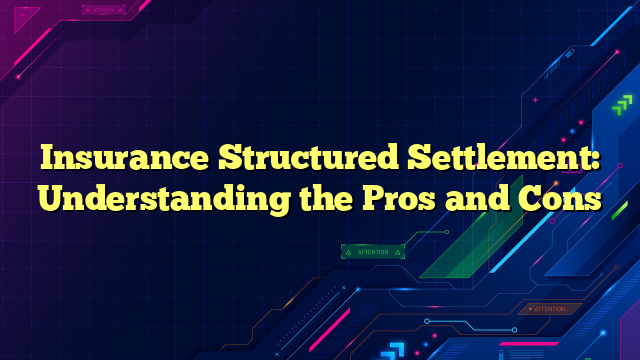Introduction:
Hello PortalSindo Friend,
When it comes to settling a legal claim, there are various options available. One of the most popular choices is a structured settlement. It is a financial agreement between the plaintiff and defendant in which the plaintiff receives periodic payments instead of a lump sum. Although it offers several benefits, it also has its downsides. In this article, we will discuss everything you need to know about insurance structured settlement, its pros and cons, and whether it is the right option for you.
What is an Insurance Structured Settlement?
An insurance structured settlement is a type of structured settlement that is funded by an annuity purchased from a life insurance company. It is commonly used to resolve personal injury or wrongful death claims. The payments are usually tax-free, and the money is guaranteed by the insurance company. The payments can be tailored to meet the specific needs of the plaintiff, such as medical expenses, living expenses, and education costs.
The Pros of Insurance Structured Settlement:
1. Guaranteed Income:
One of the most significant advantages of an insurance structured settlement is that it provides guaranteed income. The payments are made regularly and are not affected by market fluctuations or economic downturns. This ensures that the plaintiff has a steady stream of income for a fixed period, which can help them manage their finances effectively.
2. Tax Benefits:
Another advantage of an insurance structured settlement is that it offers tax benefits. The payments are usually tax-free, which means that the plaintiff can keep more of their money. Additionally, if the payments are made to a trust, the plaintiff can avoid estate taxes.
3. Tailored Payments:
An insurance structured settlement can be customized to meet the specific needs of the plaintiff. The payments can be structured to cover medical expenses, living expenses, education costs, and other expenses. This ensures that the plaintiff has the financial resources to meet their needs and maintain their quality of life.
4. Security:
Since the payments are guaranteed by an insurance company, the plaintiff does not have to worry about default or non-payment. This provides a sense of security and peace of mind, knowing that they will receive their payments as agreed upon.
5. No Management Required:
Once the structured settlement is in place, the plaintiff does not have to worry about managing the payments or making investment decisions. The insurance company takes care of everything, and the plaintiff can focus on their recovery or other aspects of their life.
6. Can Be Sold:
If the plaintiff needs a lump sum of cash, they can sell their structured settlement payments to a third-party buyer. This can provide them with the cash they need to cover unexpected expenses or invest in a new business venture.
7. Reduced Legal Fees:
Since insurance structured settlements are usually negotiated outside of court, the legal fees are often lower than those associated with a trial. This can save the plaintiff and defendant a significant amount of money in legal fees and court costs.
The Cons of Insurance Structured Settlement:
1. Limited Flexibility:
An insurance structured settlement provides a fixed stream of income for a fixed period. This means that the plaintiff has limited flexibility in terms of managing their finances. They cannot access the lump sum of money in case of an emergency or invest the money in a higher-return investment.
2. Inflation Risk:
Since the payments are fixed, the plaintiff is exposed to inflation risk. As the cost of living increases, the value of the payments may decrease in real terms. This can affect the plaintiff’s ability to maintain their quality of life over time.
3. No Control Over the Annuity:
The plaintiff has no control over the annuity purchased by the insurance company. This means that they cannot choose the investment options or the insurance company that provides the annuity.
4. Irreversible Decision:
Once the structured settlement is in place, it is difficult to change or reverse the decision. This means that the plaintiff may be locked into a financial agreement that no longer suits their needs.
5. Fees and Commissions:
The insurance company and the broker may charge fees and commissions for setting up the structured settlement. This can reduce the amount of money the plaintiff receives in payments.
6. Not Suitable for Everyone:
An insurance structured settlement may not be suitable for everyone. It may not be the right option if the plaintiff needs a lump sum of cash immediately or if they prefer to manage their finances themselves.
7. Lack of Transparency:
The terms and conditions of the structured settlement may not be transparent. This can make it difficult for the plaintiff to understand the costs and risks associated with the agreement.
Insurance Structured Settlement Table:
| Term | Definition |
|---|---|
| Insurance Structured Settlement | A financial agreement between the plaintiff and defendant in which the plaintiff receives periodic payments instead of a lump sum. The payments are funded by an annuity purchased from a life insurance company. |
| Guaranteed Income | The payments are made regularly and are not affected by market fluctuations or economic downturns. |
| Tax Benefits | The payments are usually tax-free, which means that the plaintiff can keep more of their money. |
| Tailored Payments | The payments can be structured to cover medical expenses, living expenses, education costs, and other expenses. |
| Security | The payments are guaranteed by an insurance company, providing a sense of security and peace of mind. |
| No Management Required | The insurance company takes care of everything, and the plaintiff can focus on their recovery or other aspects of their life. |
| Can Be Sold | The plaintiff can sell their structured settlement payments to a third-party buyer. |
| Reduced Legal Fees | The legal fees are often lower than those associated with a trial. |
| Limited Flexibility | The plaintiff has limited flexibility in terms of managing their finances. |
| Inflation Risk | The plaintiff is exposed to inflation risk. |
| No Control Over the Annuity | The plaintiff has no control over the annuity purchased by the insurance company. |
| Irreversible Decision | It is difficult to change or reverse the decision once the structured settlement is in place. |
| Fees and Commissions | The insurance company and the broker may charge fees and commissions for setting up the structured settlement. |
| Not Suitable for Everyone | An insurance structured settlement may not be suitable for everyone. |
| Lack of Transparency | The terms and conditions of the structured settlement may not be transparent. |
FAQs:
1. What is the difference between a structured settlement and a lump sum payment?
A structured settlement provides periodic payments over a fixed period, while a lump sum payment provides a single payment upfront.
2. Are the payments tax-free?
Yes, the payments are usually tax-free.
3. Can the payments be customized?
Yes, the payments can be structured to cover specific expenses.
4. What happens if the plaintiff dies before the payments end?
The payments can be transferred to the plaintiff’s heirs or beneficiaries.
5. Can the plaintiff access the lump sum of money in case of an emergency?
No, the plaintiff cannot access the lump sum of money in case of an emergency.
6. Can the plaintiff sell their structured settlement payments?
Yes, the plaintiff can sell their structured settlement payments to a third-party buyer.
7. What are the fees and commissions associated with an insurance structured settlement?
The insurance company and the broker may charge fees and commissions for setting up the structured settlement.
8. Is an insurance structured settlement suitable for everyone?
No, an insurance structured settlement may not be suitable for everyone.
9. What is the inflation risk associated with an insurance structured settlement?
The payments are fixed, which means that the plaintiff is exposed to inflation risk.
10. Is the decision reversible once the structured settlement is in place?
No, it is difficult to change or reverse the decision once the structured settlement is in place.
11. What are the legal fees associated with an insurance structured settlement?
The legal fees are often lower than those associated with a trial.
12. What happens if the insurance company goes bankrupt?
The payments are usually guaranteed by state insurance guaranty associations.
13. How long does an insurance structured settlement last?
The term of the structured settlement can be customized to meet the specific needs of the plaintiff.
Conclusion:
In conclusion, an insurance structured settlement provides several benefits, including guaranteed income, tax benefits, tailored payments, security, and reduced legal fees. However, it also has its downsides, such as limited flexibility, inflation risk, lack of control over the annuity, irreversible decision, fees and commissions, and lack of transparency. It may not be suitable for everyone, and the plaintiff should consider all the pros and cons before making a decision. If you think an insurance structured settlement is the right option for you, make sure to consult with a financial advisor or an attorney to ensure that you understand all the terms and conditions.
Closing Words:
Thank you for reading this article about insurance structured settlement. We hope that you have gained a better understanding of this financial agreement and its pros and cons. Remember to always do your research and consult with experts before making any financial decisions. This article is for informational purposes only and should not be construed as legal or financial advice. Always seek professional advice before making any decisions.






